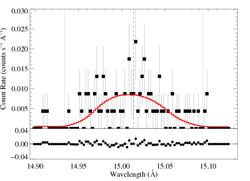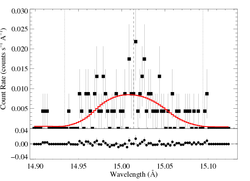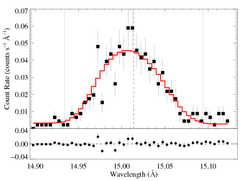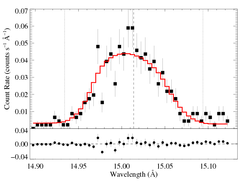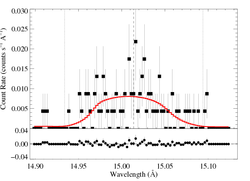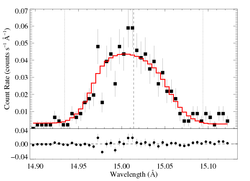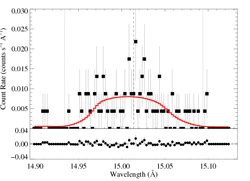Chandra HETGS line-profile analysis: resonance scattering
Supplementing Emma's analysis with resonance scattering for select lines
Emma fit standard (Owocki & Cohen 2001) line profiles, with no porosity, to the emission lines in the spectra of a dozen OB stars from the Chandra archive. Some lines in some stars seemed systematically low, perhaps due to the neglect of resonance scattering. Here, we reanalyze only those lines that look lower than the expected taustar trend and which are the most subject to resonance scattering (see Tab. 4 in Leutenegger et al. 2007). These are generally the O lines (Ly-alpha, He-alpha intercombination) and Fe XVII 15.014 A.
Emma's original fits and the taustar vs. wavelength trends she finds are available on her site. A summary can be found in Fig. 3 of her manuscript (v6c) (the figures in the manuscript are more up-to-date than those on the website).
Note that Emma used β = 1 for all her stars, because of the large amount of data she was analyzing. We'll do the same here.
ε Ori
Emma's fits to each line in this star. Her fitted taustar values.
15.014 Angstroms: Fe XVII
Emma found taustar = 0.0 with an upper limit of 0.05, and C = 237.8. That's from her website, note that the data point and error bar on the figure from her manuscript is a bit higher. Question: Is this because of a new (compared to the website) continuum model? Or the use of a different wavelength range? Or different model parameters?
Here we fit eight different model flavors, all with resonance scattering: four each with betaSob = 0, 1 using tau0star = free, 1, 5, 10.
The first four models have betaSob = 0
Note that Ro is quite high (Emma's value of ~1.7 is also high, but not as much as this; but note too, that epsilon Ori seems to have more scatter in its Ro values than any other star (see Fig. 4 in Emma's manuscript)). Also, the resonance scattering optical depth is poorly constrained. Looking at how fixed values of this parameter to investigate resonance scattering's effect on the derived taustar values therefore seems like a good way to go.
The next four models have betaSob = 1
Details of the fitting are in the xspec log file.
Note that all eight fits shown above are of similar quality, and the model profiles all look quite similar.
The taustar values are about twice as high for the betaSob = 0 models, as compared to the betaSob = 1 models. And as expected, the higher tau0star fits give higher taustar values. The largest taustar upper limit is nearly unity, but even tau0star = 1 models have upper limits of several tenths. When I fit this line, over this wavelength range and with this continuum level, both MEG and HEG fit together, with a non-porous, no-resonance-scattering model, I find a best-fit taustar = 0.06 with a 68% upper confidence limit of 0.17. (Emma's results agree with this.) So even modestly optically thick resonance scattering increases the range of acceptable taustar values, though you have to go to betaSob = 0 and/or moderately optically thick resonance scattering before the value (and confidence limits) of taustar increase significantly.
last modified: 12 August 2011

